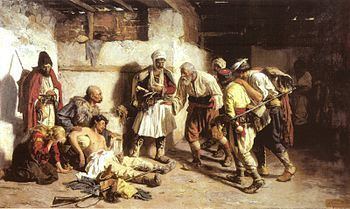Around ~6,000 Around 40,000 | Dates 18 Jun 1876 – 19 Feb 1878 | |
 | ||
Similar Herzegovina uprising, Congo Arab war, Victorio's War, Second Samoan Civil War, Second Madagascar expedition | ||
Montenegrin ottoman war 1876 78
The Montenegrin–Ottoman War (Montenegrin: Црногорско-турски рат/Crnogorsko-turski rat, "Montenegrin-Turkish War"), also known in Montenegro as "Great War" (Velji rat), was fought between the Principality of Montenegro and the Ottoman Empire between 1876 and 1878. The war ended with Montenegrin victory. Six major and 27 smaller battles were fought, among which was the crucial Battle of Vučji Do.
Contents
A rebellion in nearby Herzegovina sparked a series of rebellions and uprisings against the Ottomans in Europe. Montenegro and Serbia agreed to declare a war on Turkey on 18 June 1876. The Montenegrins allied themselves with Herzegovians. One battle that was crucial to Montenegro's victory in the war was the Battle of Vučji Do. In 1877, Montenegrins fought heavy battles along the borders of Herzegovina and Albania. Prince Nicholas took the initiative and counterattacked the Turkish forces that were coming from the north, south and west. He conquered Nikšić (24 September 1877), Bar (10 January 1878), Ulcinj (20 January 1878), Grmožur (26 January 1878) and Vranjina and Lesendro (30 January 1878)
The war ended when the Ottomans signed a truce with the Montenegrins at Edirne on 13 January 1878. The advancement of Russian forces toward Turkey forced Turkey to sign a peace treaty on 3 March 1878, recognising the independence of Montenegro, as well as Romania and Serbia, and also increased Montenegro's territory from 4,405 km² to 9,475 km². Montenegro also gained the towns of Nikšić, Kolašin, Spuž, Podgorica, Žabljak, Bar, as well as access to the sea.
Background
In October 1874, an influential Ottoman statesman, Jusuf-beg Krnjić, was murdered in Podgorica, which at the time was an Ottoman town near the border with Montenegro. He had most likely been killed by a close relative of Marko Miljanov, a Montenegrin general. In revenge, the Turks retaliated against the local population and merchants. This event is known as the "Podgorica slaughter" (Podgorički pokolj). It resulted in bad relations between Montenegro and the Ottoman Empire, which further deteriorated with the outbreak of the uprising in Herzegovina (1875). Montenegro provided the rebels with military and financial aid and represented their interests to the Porte. Montenegro requested that part of Herzegovina be handed over to the Montenegrins, but the Porte declined. Because of this, Montenegro declared war on 18 June 1876, immediately followed by its foremost ally, the Principality of Serbia.
1876
In the beginning of the war, when Miljanov arrived at Kuči, at the Ottoman frontier, the Kuči revolted and attacked the Turks. The Pasha filled Medun and other small forts, Fundina, Koći, Zatrijebač and Orahovo with soldiers.
The Piperi and Kuči tribes together attacked Koći, killing a small part, while they found Turks in tower houses whom they wanted to destroy with wooden cannons. An epic poem about the war tells how Abdi Pasha the Cherkessian with 20,000 soldiers of the sanjak of Scutari was sent by the sultan to attack the Kuči and Piperi. The poem tells how part of the army advanced on Koći and then fought in Zatrijebač and Fundina.
